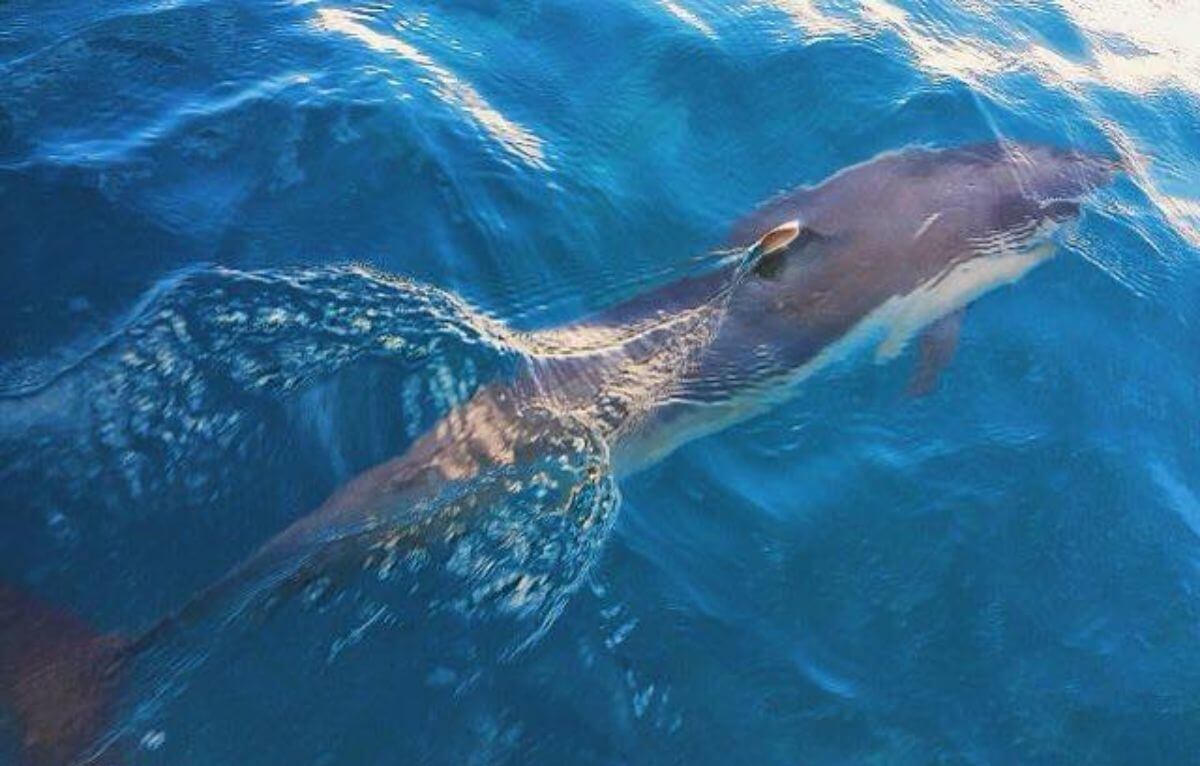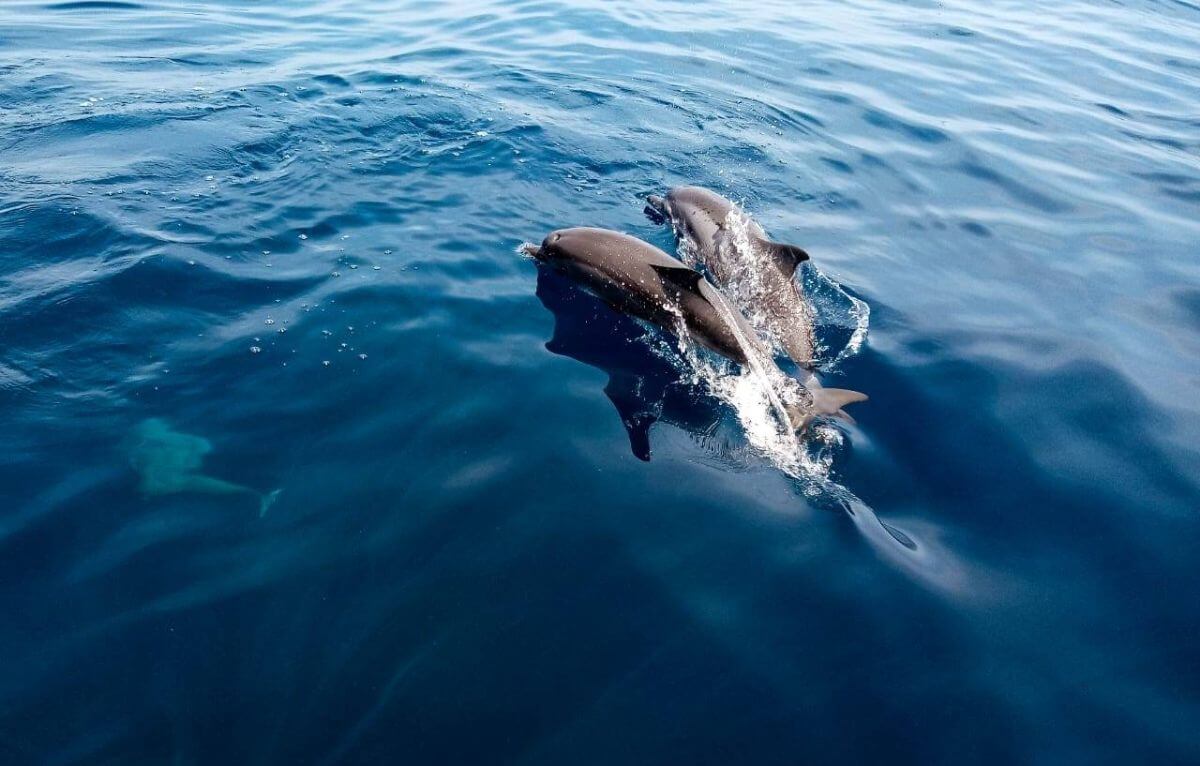HOW TO HAVE A RESPONSIBLE DOLPHIN ENCOUNTER IN THE MALDIVES

We challenge you not to smile when you see a dolphin! They are hard not to love, they are smart and fun to watch as they almost dance in the water.
It’s definitely worth keeping your eyes open whenever you are out on the ocean in the Maldives as you never know when you will be lucky enough to spot them. Dolphins can be frequently encountered in lagoons, channels and the open ocean within and around the atolls. The ocean is almost a super highway for them! The Spinner Dolphin is the most common species of dolphin you are likely to observe, while other species include the Spotted Dolphin, Indo-Pacific Dolphin and the Bottlenose Dolphin.
DOLPHIN BEHAVIOUR
We are often asked what are the dolphins doing, are they just out for a swim? There are a number of activities dolphins could be engaged in and these include:
Feeding: Dolphins are opportunistic feeders and feed on a variety of prey, including fish, squid, and crustaceans. They use various techniques to catch their food, including chasing schools of fish, herding prey into tight groups and using echolocation to locate hidden prey.
Socializing: Dolphins are highly social animals and often swim in groups known as pods, for protection and companionship. In these pods, they engage in social behaviors such as play, grooming, and communication.
Traveling: Dolphins are constantly on the move, swimming from place to place to find food and socialize with other dolphins.
Resting: Dolphins need to rest and sleep and they do so by swimming slowly at the surface of the water and taking short naps.
FIVE FUN DOLPHIN FACTS
1. Dolphins are considered to be one of the most intelligent animals on the planet, with complex social structures, problem-solving abilities, and the ability to use tools.
2. Dolphins use echolocation, a biological sonar, to navigate and locate prey. They emit high-pitched sounds that bounce off objects and return to the dolphin as echoes, which the dolphin uses to build a mental image of its surroundings. Interestingly it is dolphin teeth, not ears, that pick up the echoes that bounce back from echolocation.
3. When sleeping, half of a dolphin’s brain goes to sleep while the other half stays awake. This allows the dolphin to continue breathing in order to keep from drowning..
4. Just like human fingerprints, each dolphin has unique markings on its dorsal fin that can be used to identify individual dolphins. This helps researchers to keep track of populations and monitor the health of dolphin populations.
5. Dolphin eyes can move separately from one other. This can be extremely useful in observing their surroundings, especially when imminent danger is present.

HOW TO HAVE A RESPONSIBLE ENCOUNTER
There is a code of conduct for safe and responsible dolphin encounters. These guidelines, are designed to minimize disturbance to the dolphins and protect their natural behavior. Here are some common elements of the code of conduct for dolphin encounters:
Respect the animals: Do not chase, touch, or feed the dolphins.
Observe from a distance: Observe dolphins from a safe distance, and do not approach from directly behind or head on which can startle or stress them. While there is no strictly defined boundary, each encounter will be different and the comfort zone might alter while watching the same group.
Approach them carefully: Approach dolphins slowly from the side. It is best you maintain the boat in a parallel position and slightly behind the group at a speed of 6 knots when within 150 metres. Avoid sudden changes in speed and direction. Dolphins can hear you coming from much further away than you can see them. Therefore, your engine is a means of “communication” with the dolphins. You should accelerate or decelerate gradually in their vicinity. Putting your engine in gear, changing speed or direction is alarming for the dolphins, so try to be consistent.
Give them space: Do not come closer than 50 m. Let them decide to approach you. If there are other boats around, increase the distance from the group. Too many boats surrounding the dolphins at the same time will have a negative effect. If there are others boats actively viewing the animals, wait for them to leave before you come closer. There should not be more than three boats within 200 m of the group.
Consider the position of your boat: Do not have boats positioned on all sides of the dolphins. Surrounding them will create a feeling of entrapment and they will try to escape. All vessels should be on one side of the group, allowing them enough room to change course without obstruction.
Do not touch dolphins: As with all marine life tactile interaction with dolphins may result in disease transfer which could present serious health threats to dolphins and humans alike.
Do not feed dolphins: Feeding dolphins can lead to a dependency on humans and cause health problems. It is also illegal in many areas.
Be aware of changes to behaviour: Dolphins will let you know if you are not welcome. Leave immediately if you hear loud exhalation or observe tail slapping, prolonged dives or changes in swimming speed or direction including repeatedly swimming directly towards and away from the boat.
Do not overstay your welcome: Dolphins are wild animals and need to go on with their daily activities to ensure their survival, stay with the animals for up to 30 minutes and then accelerate gradually when leaving.
Avoid mothers with calves: If you observe mothers with small calves, leave immediately because young animals are particularly vulnerable to stress. You might also be interfering with a critical period designated to nursing a new-born, rest or feeding and they simply do not want you around. Females or the entire group will often try to position themselves between the calf and the boat in an attempt to shield the offspring. This is a definite sign you should move away.
By following these guidelines, you can help protect the dolphins and their habitat, and ensure that encounters are safe and enjoyable for both you and the dolphins.

CAN I SWIM WITH DOLPHINS?
While you may be lucky to encounter dolphins close up when you are in the water either diving or snorkeling, it is not a common occurrence and we would advise against attempting to swim with them. Dolphins can move through water much faster than any swimmer so chasing them around is not going to give you a chance for a closer look.
While people in the water may become objects of interest for nearby dolphins, their curiosity should not be misinterpreted as friendly behaviour. A swimmer immersed in their habitat is foremost a foreign and unfamiliar object that needs to be investigated. By trying to seek out their attention, you are disrupting their natural behaviour and forcing them to abandon their current activities such as resting, feeding and socialising. You may force resting animals to move and expend energy, often to unfavourable areas where they are exposed to even more stress.
Your presence itself represents a disturbance, regardless of your behaviour and the repeated presence of people in the water can also have the effect of decreasing fear of human interaction making them more vulnerable to boat strikes, entanglement in fishing gear or even intentional harassment.
Observing dolphins from a boat or the shoreline is still very rewarding and allows you an encounter that we are sure will still be memorable.
Thank you to Marine Savers and Blue World Institute for their education and advise in writing this article.
Join us daily on our Sandbank, Snorkeling and Sunset Tour where there is always the opportunity to encounter dolphins!